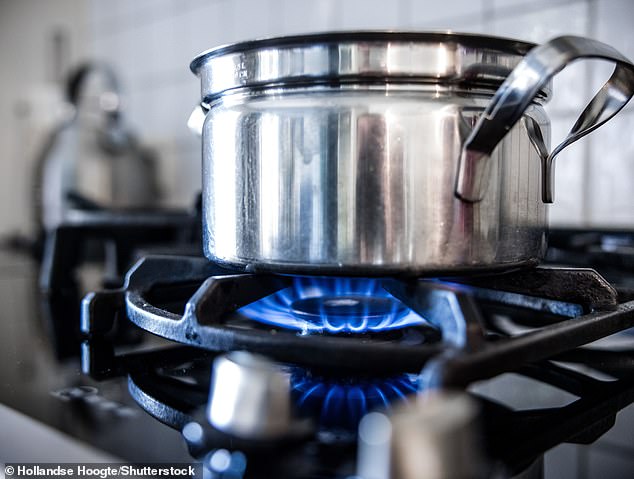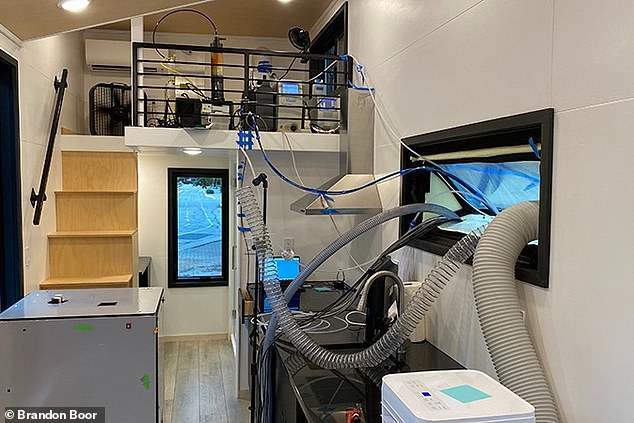The natural gas stove in your home could be emitting more harmful nanoparticles than the tailpipe of a gasoline-powered car, according to new research.
Clouds of these tiny particles, also known as soot, measure between one and three nanometers each. They are just the right size to penetrate the lungs and infiltrate the bloodstream, said the Purdue University and Indiana University scientists who conducted the new study.
Researchers found that cooking was easy The grilled cheese sandwich can expose residents to up to 10 million nanocluster aerosols per cubic nanometer, cCompared to the million or so that cars release near a busy street.
The news comes about a year after some officials at the U.S. Consumer Product Safety Commission considered banning gas stoves, a move that never materialized but became a political lightning rod.

Gas stoves have been shown to emit nitrogen oxide, carbon monoxide and fine particulate matter, each of which has been shown to have negative effects on human health. The new study shows how long those fine particles can remain in the home.


Researchers at Purdue University use this at-home test to study the effects of cooking with gas stoves on indoor air quality.
Being exposed to millions of particles, even for relatively short periods of 24 hours, can be harmfulaccording to the California Air Resources Board.
Nanocluster aerosols can contribute to respiratory diseases such as asthma and bronchitis, and increase a person’s chances of going to the hospital for heart or lung causes.
Exposure to these nanoparticles has even been linked to dementia and cognitive decline.
More than one-third of households in the USAbout 47 million have propane or natural gas stoves.
“Combustion continues to be a source of air pollution around the world, both indoors and outdoors,” the study’s lead author, Brandon Boor, an associate professor of civil engineering at Purdue, said in a statement.
“We found that cooking on a gas stove produces large amounts of small nanoparticles that enter the respiratory system and deposit efficiently.”
The team used an air quality system to test nanoparticles inside a “tiny house” laboratory, which was equipped with sensors to closely monitor the impact of everyday activities on a home’s air quality.
In addition to measuring how many nanocluster aerosol particles a propane stove generates, the scientists also used computer models to estimate how many particles someone might breathe.
Trillions of nanocluster aerosol particles were emitted in just 20 minutes after boiling water or making grilled cheese sandwiches or buttermilk pancakes on a gas stove.
And during that 20-minute period, they estimated that an adult could inhale between 10 billion and a trillion of those particles.
This is between 10 and 100 times the dose of soot you would receive if you were standing on a busy street for the same period of time, the study authors wrote.
The study only looked at nanoparticles from gas stoves and cars, not other air pollutants such as nitrogen oxide or carbon monoxide.
It was also found that the nanocluster aerosol coming from the gas stove mixes easily with larger particles entering the air from butter, oil, or whatever else is being cooked on the gas stove.
Although particle concentrations increased rapidly during cooking, peaking after about 20 minutes, they quickly dissipated.


An internal combustion engine produces fine particles in the form of nanocluster aerosols, like those examined in the new study. Scientists found that road exhaust actually contains a similar concentration of nanocluster aerosols as a kitchen gas stove, sometimes less.


The study’s lead author, Brandon Boor, said the small particles created by gas stoves should be considered a unique form of pollutant.
The data indicate that particles settle out of the air almost as quickly and return to initial levels within 10 to 20 minutes.
This is probably due to the combined effects of ventilation and the fact that particles settle on surfaces.
The situation is similar with cars: as long as they are broadcasting, they are in the air. But once the stove goes out or the cars stop passing by, the soot soon settles.
Fortunately, there is a simple way to reduce the concentration of these harmful particles.
For people who have one of these stoves in their home, the scientists behind the study recommend turning on a fan every time you cook on it.
“Since most people don’t turn on the exhaust fan while cooking, having kitchen hoods that activate automatically would be a logical solution,” Boor said.
“Looking ahead, we need to think about how to reduce our exposure to all types of indoor air pollutants,” he continued. “Based on our new data, we recommend that nanocluster aerosols be considered a distinct category of air pollutant.”
He study was published on Tuesday in the magazine PNAS Nexus.
Despite a proposed ban on gas stoves in 2023, there have been no new federal rules regulating the appliances, after public backlash led the CPSC to rethink its stance.
It is difficult to definitively link gas stoves to illnesses in people, which has sparked heated debate over whether a ban is justified.
However, some local governments have attempted to create new rules based on research showing that gas stoves produce high levels of indoor pollutants.
Berkeley, California, for example, banned them in 2019, but a court overturned the ban last year.
New York Governor Kathy Hochul has said she wants to ban them in new buildings by 2030, but She is running for re-election in 2026.

